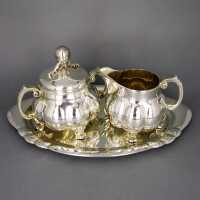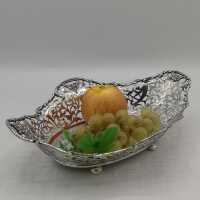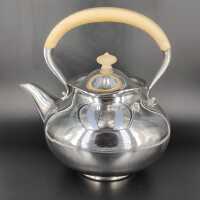An exquisite masterpiece of the Georgian era: this antique mustard pot, made in 1829 by Jonathan Hayne in London, represents the elegance and craftsmanship of the early 19th century. Made from the finest 925/- sterling silver, this collector's item is enthroned on a rising, segmented base that not only provides stability but also a touch of grandeur.
The body of the mustard pot demonstrates a refined sense of aesthetics: a segmented, rectangular baluster body with gently rounded corners gives it an unmistakable shape. The finely crafted cord edge emphasises the classic design and adds a subtle but effective texture. A special highlight is the hinged, domed lid, crowned by an attractive ball knob that makes opening and closing a small ritual.
Inside, the mustard pot surprises with a gold-plated interior that is not only visually appealing, but also functional: the gold plating protects the silver from the corrosive properties of the mustard and ensures that the piece will last a long time. The flat handle of the pot ensures comfortable handling and blends seamlessly into the overall design.
Another detail that emphasises the history and exclusivity of this piece is the engraved aristocratic coat of arms on the lid - a testament to its aristocratic origins and the times in which it was made.
This exquisite mustard pot is complemented by a matching mustard spoon, made in 1835 by Charles Boyton, also in London. This spoon, a perfect complement to the pot, adds to the authenticity and completeness of this museum collector's item.
A testament to Georgian silversmithing and historical elegance, this mustard pot is far more than just a utilitarian object: it is a piece of history that has stood the test of time and deserves a place of honour in any collection of antique silverware.
Dimensions & details
- Sterling silver 925/-
- Weight 166.62 with spoon
- Width 9.5 cm
- Height 7.2 cm



